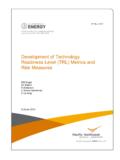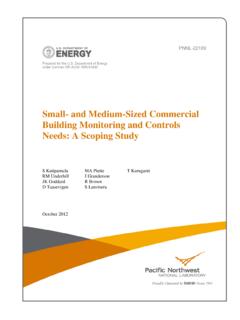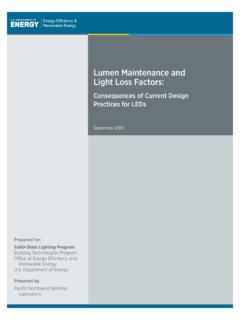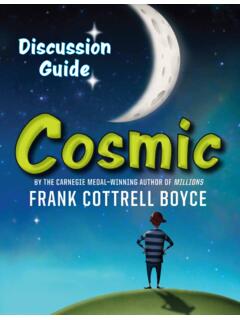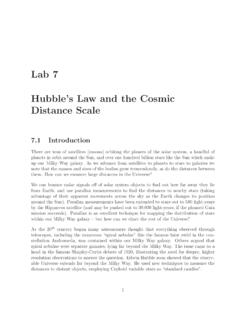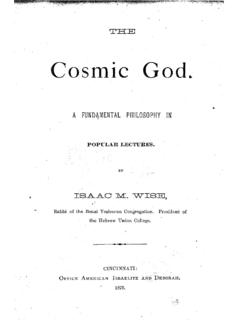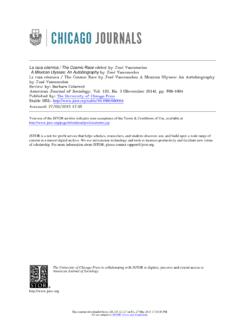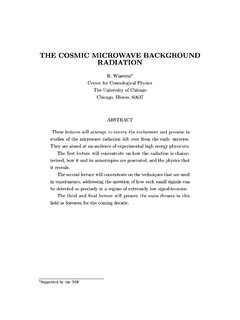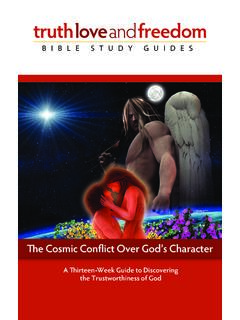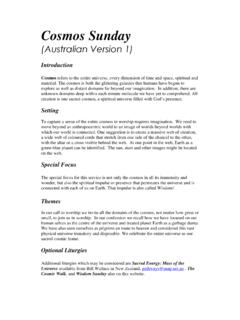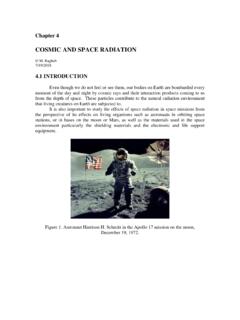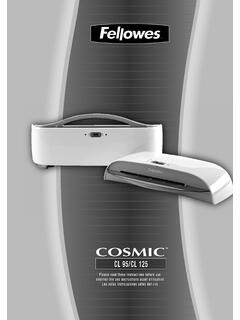Transcription of Cosmic Ray Interactions in Shielding Materials - …
1 PNNL-20693 Prepared for the Department of Energy under Contract DE-AC05-76RL01830 Cosmic Ray Interactions in Shielding Materials E Aguayo RT Kouzes AS Ankney1 JL Orrell TJ Berguson1 MD Troy2 July 2011 1 Juniata College 2 Wittenberg University PNNL-20693 Cosmic Ray Interactions in Shielding Materials E Aguayo RT Kouzes AS Ankney1 JL Orrell TJ Berguson1 MD Troy2 July 2011 Prepared for the Department of Energy under Contract DE-AC05-76RL01830 Pacific Northwest National Laboratory Richland, Washington 99352 1 Juniata College 2 Wittenberg University PNNL-20693 iii Summary This document provides a detailed study of Materials used to shield against the hadronic particles from Cosmic ray showers at Earth s surface.
2 This work was motivated by the need for a shield that minimizes activation of the enriched germanium during transport for the MAJORANA collaboration. The Materials suitable for Cosmic -ray shield design are Materials such as lead and iron that will stop the primary protons, and Materials like polyethylene, borated polyethylene, concrete and water that will stop the induced neutrons. The interaction of the different Cosmic -ray components at ground level (protons, neutrons, muons) with their wide energy range (from kilo-electron volts to giga-electron volts) is a complex calculation. Monte Carlo calculations have proven to be a suitable tool for the simulation of nucleon transport, including hadron Interactions and radioactive isotope production.
3 The Monte Carlo simulation tool Geant4 was used for this study. This document is structured to explicitly present the data and its analysis for the six different Materials considered. Each material is analyzed according to it geometry, considering ten different thicknesses of each material plus no material. The intent of this document is to provide practical guidance in the choice of Shielding material for the energy range of interest (20 MeV to 10 GeV) and its particular configuration. The hydrogenous Materials modeled for this study were polyethylene (PE), borated polyethylene (BPE), and water. The effectiveness of each of these Materials in Shielding Cosmic neutrons, protons and muons was similarly poor.
4 None of these is therefore recommended as a material to consider in Shielding the detector Materials in transport from Cosmic rays. The result of this study is the assertion that activation at Earth s surface is a result of the neutronic and protonic components of the Cosmic -ray shower. The best material to shield against these Cosmic -ray components is iron, which has the best combination of primary Shielding and minimal secondary neutron production. PNNL-20693 v Acronyms and Abbreviations 0 Neutrinoless double-beta decay 2 Two-neutrino double beta decay BPE Borated polyethylene CERN The European Organization for Nuclear Research (French: Organisation Europ enne pour la Recherche Nucl aire) Geant4 Geometry and Transport 4 HPGe High-purity germanium MJD MAJORANA DEMONSTRATOR PE Polyethylene PEEK Polyether ether ketone PNNL Pacific Northwest National Laboratory PNNL-20693 vii Contents Introduction.
5 1 Monte Carlo Tool Description .. 4 Geant4 .. 4 CRY .. 5 ROOT .. 5 Material characterization .. 6 Iron .. 6 Sea Level Neutrons .. 6 Sea level Protons .. 9 Sea Level Muons .. 12 Lead .. 15 Sea Level Neutrons .. 15 Sea level Protons .. 18 Sea Level Muons .. 21 Polyethylene .. 24 Sea Level Neutrons .. 24 Sea level Protons .. 27 Sea Level Muons .. 30 Borated Polyethylene .. 33 Sea Level Neutrons .. 33 Sea level Protons .. 36 Sea Level Muons .. 39 Water .. 42 Sea Level Neutrons .. 42 Sea level Protons .. 45 Sea Level Muons .. 48 Concrete .. 51 Sea Level Neutrons .. 51 Sea Level Protons .. 54 Sea Level Muons .. 57 Results .. 60 Twenty Mega-Electron Volt to Ten Giga-Electron Volt Energy Range of the Cosmic Flux 60 Conclusions.
6 64 References .. 66 Appendix A : Low- and Very High-Energy Ranges .. PNNL-20693 viii Figures Figure 1: Cosmic Neutron Flux through Iron .. 7 Figure 2: Simulated Spectra for Cosmic Neutrons through 0 cm to 100 cm of Iron .. 8 Figure 3: Cosmic Proton Flux through Iron .. 9 Figure 4: Simulated Spectra for Cosmic Protons through 0 cm to 100 cm of Iron .. 11 Figure 5: Cosmic Muon Flux through Iron .. 12 Figure 6: Simulated Spectra for Cosmic Muons through 0 cm to 100 cm of Iron .. 14 Figure 7: Cosmic Neutron Flux through Lead .. 15 Figure 8: Simulated Spectra for Cosmic Neutrons through 0 cm to 100 cm of Lead .. 17 Figure 9: Cosmic Proton Flux through Lead .. 18 Figure 10: Simulated Spectra for Cosmic Protons through 0 cm to 100 cm of Lead.
7 20 Figure 11: Cosmic Muon Flux through Lead .. 21 Figure 12: Simulated Spectra for Cosmic Muons through 0 cm to 100 cm of Lead .. 23 Figure 13: Cosmic Neutron Flux through Polyethylene .. 24 Figure 14: Simulated Spectra for Cosmic Neutrons through 0 cm to 100 cm of Polyethylene .. 26 Figure 15: Cosmic Proton Flux through 27 Figure 16: Simulated Spectra for Cosmic Protons through 0 cm to 100 cm of Polyethylene .. 29 Figure 17: Cosmic Muon Flux through Polyethylene .. 30 Figure 18: Simulated Spectra for Cosmic Muons through 0 cm to 100 cm of 32 Figure 19: Cosmic Neutron Flux through Borated 33 Figure 20: Simulated Spectra for Cosmic Neutrons through 0 cm to 100 cm of Borated 35 Figure 21: Cosmic Proton Flux through Borated Polyethylene.
8 36 Figure 22: Simulated Spectra for Cosmic Protons through 0 cm to 100 cm of Borated 38 Figure 23: Cosmic Muon Flux through Borated Polyethylene .. 39 Figure 24: Simulated Spectra for Cosmic Muons through 0 cm to 100 cm of Borated 41 Figure 25: Cosmic Neutron Flux through Water .. 42 Figure 26: Simulated Spectra for Cosmic Neutrons through 0 cm to 100 cm of Water .. 44 Figure 27: Cosmic Proton Flux through Water .. 45 Figure 28: Simulated Spectra for Cosmic Protons through 0 cm to 100 cm of Water .. 47 PNNL-20693 ix Figure 29: Cosmic Muon Flux through Water .. 48 Figure 30: Simulated Spectra for Cosmic Muons through 0 cm to 100 cm of Water .. 50 Figure 31: Cosmic Neutron Flux through 51 Figure 32: Simulated Spectra for Cosmic Neutrons through 0 cm to 100 cm of Concrete.
9 53 Figure 33: Cosmic Proton Flux through Concrete .. 54 Figure 34: Simulated Spectra for Cosmic Protons through 0 cm to 100 cm of Concrete .. 56 Figure 35: Cosmic Muon Flux through Concrete .. 57 Figure 36: Simulated Spectra for Cosmic Muons through 0 cm to 100 cm of concrete .. 59 Figure 37: High-Energy Outbound Neutron Flux versus Material Thickness for All Materials Considered in This Study .. 60 Figure 38: High-Energy Outbound Proton Flux versus Material Thickness for All Materials Considered in This Study .. 61 Figure 39: Outbound Total Neutron and Proton Flux through 100 cm of All Materials Considered in This Study .. 65 Figure 40: Low-Energy Outbound Neutron Flux versus Material Thickness for All Materials Considered in This Study.
10 Figure 41: Low-Energy Outbound Proton Flux versus Material Thickness for All Materials Considered in This Study .. Figure 42: Outbound Total Low-Energy Neutron and Proton Flux through 100 cm of All Materials Considered in This Study .. Figure 43: High-Energy Outbound Neutron Flux versus Material Thickness for All Materials Considered in This Study .. PNNL-20693 x Tables Table 1: Calculated Energy Q-values for the Neutronic 68Ge Reactions .. 2 Table 2: Calculated Energy Q-values for the Neutronic 60Co Reactions .. 2 Table 3: MAJORANA DEMONSTRATOR Background Budget (Detwiler 2011) .. 3 Table 4: Software Versions Used in This Work (Aguayo-Navarrete et al. 2010) .. 4 Table 5: Cosmic Neutron Flux through Iron.





